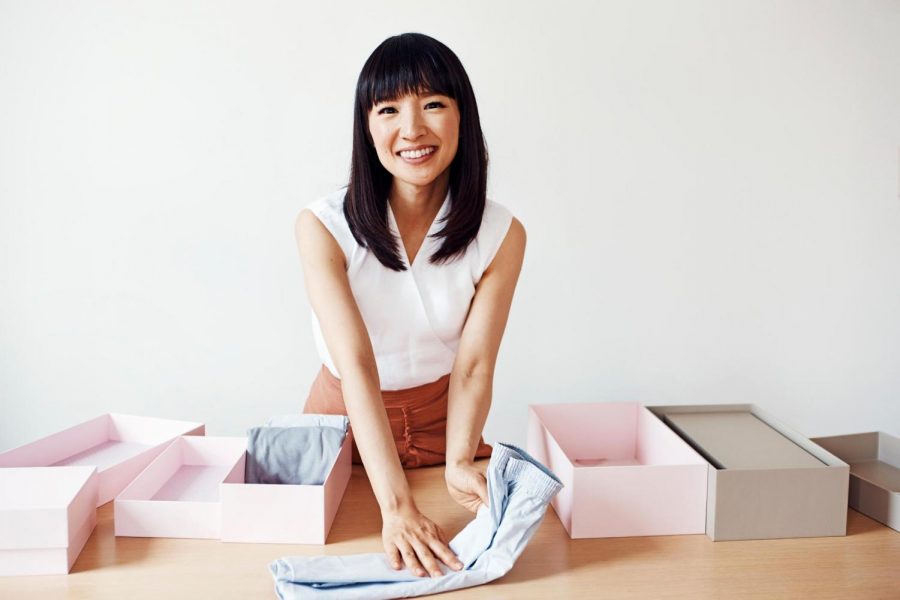Netflix’s “Tidying Up with Marie Kondo” Surpasses HGTV
TV stars such as Jonathan and Drew Scott or Joanna and Chip Gaines have been the faces of the art of renovating or improving home living, and HGTV viewers watch in awe as they almost magically decorate houses into dream homes. While in many HGTV shows, the professionals do all the work fixing houses for the homeowners, in the new Netflix series “Tidying Up with Marie Kondo,” Japanese consultant Kondo teaches methods for the homeowners to tidy up their houses on their own, and she does so in a humble, sweet and joyful manner.
Netflix released “Tidying Up with Marie Kondo” on Jan. 1—the perfect time for viewers to watch a show about getting organized as they seek to fulfill New Year’s resolutions. In each episode, Kondo helps homeowners, whether empty-nesters, newlyweds or new parents, to tidy up their houses with her KonMari method. They organize items in a specific order: clothing, books, paper, komono (including miscellaneous items, the kitchen, bathroom and garage) then sentimental items.
To some people, Kondo’s method may seem cheesy, especially as she says hello to the house and thank you to the clothes that people discard. In fact, when Kondo was on the Ellen Degeneres show, she demonstrated the proper way to fold a shirt—pat with care, create a rectangle in the middle, fold in half, fold in third and stand up as a small rectangle—but instead of accepting the method, Ellen found it humorous, made jokes out of it and almost mocked it. People have even made a meme out of Kondo’s spark joy philosophy, which is deciding whether or not to keep an item based on if it makes one feel joyful.
However cheesy it seems, one must truly get into the essence to understand and ultimately appreciate the positive effects of her method. Cleansing a house can be very spiritual and helps people to understand what means the most to them in their lives, and the process of cleaning can actually change the homeowners’ mentality to make them more at ease and connect with their partners better.
She teaches that tidying up is appreciating what one has, and the only way to confront just how much one has is for homeowners have to put all possessions in a big pile, or a clothes mountain for clothing. People who watch the show have been inspired by this method, so much so that thrift shops and goodwill have seen an influx in donations of items that do not spark joy for their current owners but could for their future owners. For the items that do spark joy, once everything is organized, Kondo advises to sort items in a way that people always can see the quantity of everything that they own, whether by standing clothes up, putting miscellaneous items in compartmentalized boxes or hanging photographs on walls.
In the show Kondo mainly speaks Japanese, with only a little English, so she has a translator. Some people may see this as a disconnect between her and the American families that she helps, but on the contrary, the so-called clash of cultures helps to build perspective. Japan is a small country with many people, so the Japanese have to learn to be resourceful in limited space; however, Americans do not have that issue, since the American dream is about having large estates with unlimited space. In turn, Kondo has a perspective that helps the homeowners to be less materialistic.
In HGTV shows, the big reveal is always the most anticipated part of the show, where the stars of the show take the homeowners on a tour of their new house. While people may live vicariously through the success of the TV homeowners’ house, no lessons can be learned, because the homeowners are lucky enough to spend money to have people work for them. This is not the case for Kondo’s show; it is actually reversed. The big reveal is when the homeowners show her just how much work they did themselves after she taught them her methods, and that teaches viewers that they can be empowered to make a difference in their own lives and do not have to wait for or pay loads of money to make their dream living situation come true.
Unlike HGTV personalities who have a high aura of perfection, Kondo admits that she is not perfect, just like the homeowners. She humbly mentions that she too can get tired or be messy, which humanizes her. Her joyful energy lightens up the show and makes the subjects of the show and viewers alike get inspired to use cleaning up as a chance to discover and appreciate what they have.

Katie Hurwitz, class of 2019, is the Online Managing Editor and Entertainment Editor for The Rebellion. At school, Katie is involved in National Honor...












